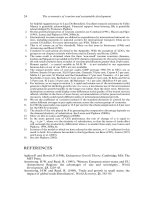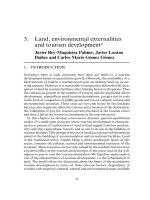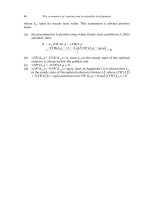THE ECONOMICS OF MONEY,BANKING, AND FINANCIAL MARKETS 426
Bạn đang xem bản rút gọn của tài liệu. Xem và tải ngay bản đầy đủ của tài liệu tại đây (46.38 KB, 1 trang )
394
PA R T V
Central Banking and the Conduct of Monetary Policy
INSIDE THE CENTRAL BANK
The Special Role of the Federal Reserve Bank of New York
The Federal Reserve Bank of New York plays a
special role in the Federal Reserve System for
several reasons. First, its district contains many of
the largest commercial banks in the United States,
the safety and soundness of which are paramount to the health of the U.S. financial system.
The Federal Reserve Bank of New York conducts
examinations of bank holding companies and
state-chartered member banks in its district, making it the supervisor of some of the most important financial institutions in the U.S. financial
system. Not surprisingly, given this responsibility,
the bank supervision group is one of the largest
units of the New York Fed and is by far the largest
bank supervision group in the Federal Reserve
System.
The second reason for the New York Fed s
special role is its active involvement in the bond
and foreign exchange markets. The New York
Fed houses the open market desk, which conducts open market operations the purchase
and sale of bonds that determine the amount
of reserves in the banking system. Because of
this involvement in the Treasury securities market, as well as its walking-distance location near
the New York and American Stock Exchanges,
the officials at the Federal Reserve Bank of New
York are in constant contact with the major
financial markets in the United States. In addition, the Federal Reserve Bank of New York
houses the foreign exchange desk, which conducts foreign exchange interventions on behalf
of the Federal Reserve System and the U.S.
European
Central Bank
Treasury. Its involvement in these financial markets means that the New York Fed is an important source of information on what is happening
in U.S. and foreign financial markets, particularly during crisis periods, such as the recent
subprime meltdown, as well as a liaison
between officials in the Federal Reserve System
and private participants in the markets.
The third reason for the Federal Reserve Bank
of New York s prominence is that it is the only
Federal Reserve bank to be a member of the Bank
for International Settlements (BIS). Thus the
president of the New York Fed, along with the
chairman of the Board of Governors, represents
the Federal Reserve System in its regular monthly
meetings with other major central bankers at
the BIS. This close contact with foreign central
bankers and interaction with foreign exchange
markets means that the New York Fed has a special role in international relations, both with other
central bankers and with private market participants. Adding to its prominence in international
circles is that the New York Fed is the repository
for more than US$100 billion of the world s gold,
an amount greater than the gold at Fort Knox.
Finally, the president of the Federal Reserve
Bank of New York is the only permanent member of the FOMC among the Federal Reserve
bank presidents, serving as the vice-chairman of
the committee. Thus he and the chairman and
vice-chairman of the Board of Governors are the
three most important officials in the Federal
Reserve System.
Until recently, the Federal Reserve had no rivals in terms of importance in the central
banking world. However, this situation changed in January 1999 with the start-up of
the European Central Bank (ECB) the central bank of the sixteen euro area countries which now conducts monetary policy for countries that are members of the
European Monetary Union. These countries, taken together, have a population that
exceeds that in the United States and a GDP comparable to that of the United States.
The Maastricht Treaty, which established the ECB and the European System of
Central Banks (ESCB), patterned these institutions after the Federal Reserve, in that
central banks for each country (referred to as National Central Banks, or NCBs) have









